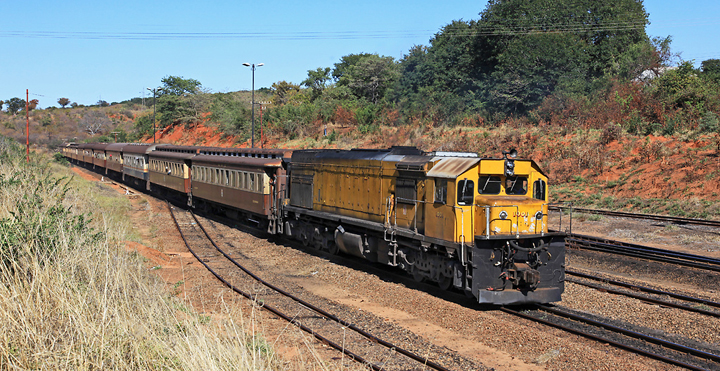Demise of the rand: The story behind

Elgin Chetsanga
WHEN did you change the fare? This is an embarrassing and sometimes uncomfortable question we have had to ask touts or windis over the past few months.
I think it’s safe to say the rapid and unannounced changes in the kombi fares have left us wondering what is happening to the rand.
Suffice to say I refer to the situation here in Bulawayo.
Harare people on the other hand have not changed their going price of five rand. Welcome to the aftermath of the rand slide against the dollar. This is both the curse and blessing of using multiple currencies.
The effects are not only felt in the kombis but by many of us who rely on support from relatives in South Africa.
Suddenly what is remitted back to us for groceries, fees and general upkeep no longer stretches as a far as it used to.
If you are coming home from working in South Africa you also meet the same fate.
The grim truth is the conversion rate from rand to dollars is simply punitive. Businesses are also feeling the pinch. Businesses which export t
South Africa have had to come face to face with a grim reality of receiving less and less value with each successive payment.
However it’s not all bad news.
The movement in the exchange rate has made good fortune for companies and individuals, who rely on imports.
This is because imports have become relatively cheaper.
For individuals the slide in value of the rand has made buying “stuff’ from South Africa a lucrative venture.
Enough about how the rand has changed our lives. I for one would like to know how the rand got to this place where it’s trending at almost US$1:15ZAR.
Is South Africa not stable economy? Are these early warning signs that the rand is headed for the same trajectory as the Zimbabwean dollar?
To answer these questions, we need to look at the fundamental contributors to the current state of affairs
A holistic probe from a historical perspective will shed more light. The South African rand has been losing ground since 2011.
In 2005 the cross-rate was US$1-ZAR6,36 in 2005.
This was followed by a gradual loss in value from 2011 from ZAR7.26 to US$ to present day levels of almost $1-15ZAR. These rates are also in line with those of money changers in the informal market.
To further appreciate the weakening of the rand, it is vital to view the South African economy not in isolation but as part of a grand scheme of global events. The structure of the South African economy is mainly anchored on commodities exports, the likes of gold, coal etc.
However, due to the slowdown in China the world biggest manufacturer the ripples have filtered everywhere in the world surprisingly not sparing South Africa.
The rand is particularly vulnerable because it is one of the globe’s most highly traded emerging market currencies. China makes one third of global output, and that means a lot of raw materials imports from the likes of South Africa. Conclusively, economies that rely on the sale of commodities – such as South Africa’s – have been hit by the slowdown in growth in China, a major source of demand.
By the way China’s economy is overheating and this will be the subject of the next article.
Secondly, South Africa has in recent years come under increased strain from domestic instabilities.
Trade union action, which took place earlier this year and last year, has made a significant dent on investor nerves.
The country output projections had to be revised, the country missed its GDP projection, implying a further blow to the currency.
In the past year South Africa’s economy has struggled to raise growth above two percent.
If an economy is not growing, the currency is not making any traction against other currencies.
Furthermore, another less knows reason for the slide in the rand is the trade deficit, which South Africa is battling with. The economy has been posting trade deficits mainly due to its imports of fuel and high value added goods while export have been hurt by several strikes in the mining sector.
Put simply, their economy has basically been importing more than it’s been exporting.
Statistics show that the trade deficit for 2013 stood at R4.13 Billion. South Africa posted a R-0.40bn deficit in July of 2015 from a downward revised R5.5b surplus a month earlier. The overall trade deficit continues to put pressure on the currency.
The rand is also being affected by internal structural weakness such as power shortages, which continue to hamper productivity.
As the countries grapples with power shortages much like Zimbabwe, the country has to deal with reduced productivity.
The power utility Eskom have even warned of steeper power cuts.
Power generation has by far since fallen behind total power consumption to the overall economy.
This was the subject of Julius Malema, opposition EFF leader’s complaint in Parliament.
The power situation has led to reduced competitiveness on the global market of South African products, generally then inducing a slump in the rand.
Thus put in perspective, deepening of the socio-economic and structural problems, slowdown in commodities markets, further downgrade by the rating agencies, and a widening current account deficit could be blamed for the rand slip.
However, the rand is not walking the fine line alone. Turbulent times prevail across Africa due to the interconnectedness of the global economy.
Several other African currencies have been under pressure in recent weeks over fears of a Chinese economic slowdown. With oil currently hovering around $40 (£25) a barrel, there are concerns about the prospects for oil-based economies, especially Nigeria and Angola.
The relative strength of the US dollar has also had an effect on – among others – the Zambian kwacha and the Ugandan shilling, which have both hit record lows in the past week.
Some of the ways we can navigate this phase may seem farfetched but practical. I for one will, going forward, avoid conversion of the currency and do as many purchases in the unit currency.
As for the businesses, an investigation into forward contracts and futures, which hedge against these anticipated interest rate movements is critical.
My view is that the immediate future is not promising but stability is on the horizon.
Elgin Chetsanga is a banking expert working for a local commercial bank. He writes in his own personal capacity.










Comments